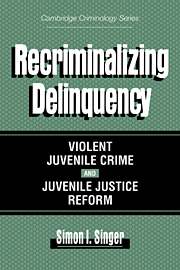Book contents
- Frontmatter
- Contents
- List of Figures and Tables
- Acknowledgments
- Introduction
- 1 Recriminalizing Violent Juvenile Crime
- 2 Taking Stock of Juvenile Justice Reforms
- 3 Recriminalization on the Move and Its Legal Rules
- 4 Contextual and Legal Reasons for Identifying Juveniles as Criminal Offenders
- 5 The Case Processing of Juvenile Offenders: From Arrest to Disposition
- 6 Recriminalization and Organizing for Deterrence
- 7 Convicted Juvenile Offenders in a Maximum Security Institution
- 8 Concluding “Real” Reasons for Recriminalizing Delinquency
- Appendixes
- A Definitions of Designated Felony Offenses
- B Survey to Measure Prosecutorial Attitudes
- C Offense Severity Weights
- Notes
- References
- Index
A - Definitions of Designated Felony Offenses
Published online by Cambridge University Press: 29 September 2009
- Frontmatter
- Contents
- List of Figures and Tables
- Acknowledgments
- Introduction
- 1 Recriminalizing Violent Juvenile Crime
- 2 Taking Stock of Juvenile Justice Reforms
- 3 Recriminalization on the Move and Its Legal Rules
- 4 Contextual and Legal Reasons for Identifying Juveniles as Criminal Offenders
- 5 The Case Processing of Juvenile Offenders: From Arrest to Disposition
- 6 Recriminalization and Organizing for Deterrence
- 7 Convicted Juvenile Offenders in a Maximum Security Institution
- 8 Concluding “Real” Reasons for Recriminalizing Delinquency
- Appendixes
- A Definitions of Designated Felony Offenses
- B Survey to Measure Prosecutorial Attitudes
- C Offense Severity Weights
- Notes
- References
- Index
Summary
Murder (125.25 A-1 Felony)
A person is guilty of murder when:
With intent to cause death of another person, he causes the death of such person or of a third person; except that in any prosecution under this subdivision, it is an affirmative defense that:
(a) The defendant acted under the influence of extreme emotional disturbance for which there was a reasonable explanation or excuse, the reasonableness of which is to be determined from the viewpoint of a person in the defendant's situation under the circumstances as the defendant believed them to be. Nothing contained in this paragraph shall constitute a defense to a prosecution for, or preclude a conviction of, manslaughter in the first degree or any other crime;
(b) The defendant's conduct consisted of causing or aiding, without the use of duress or deception, another person to commit suicide. Nothing contained in this paragraph shall constitute a defense to a prosecution for, or preclude a conviction of, manslaughter in the second degree or any other crime; or
2. Under circumstances evincing a depraved indifference to human life, he recklessly engages in conduct which creates a grave risk of death to another person; or [...]
- Type
- Chapter
- Information
- Recriminalizing DelinquencyViolent Juvenile Crime and Juvenile Justice Reform, pp. 197 - 202Publisher: Cambridge University PressPrint publication year: 1996

